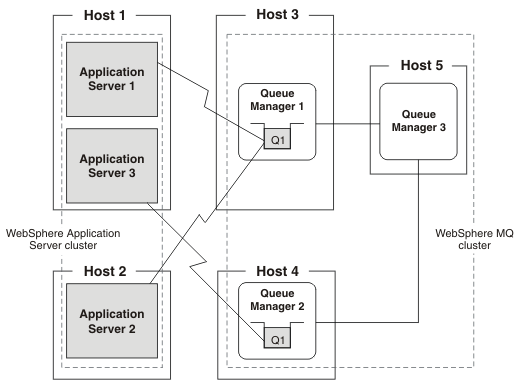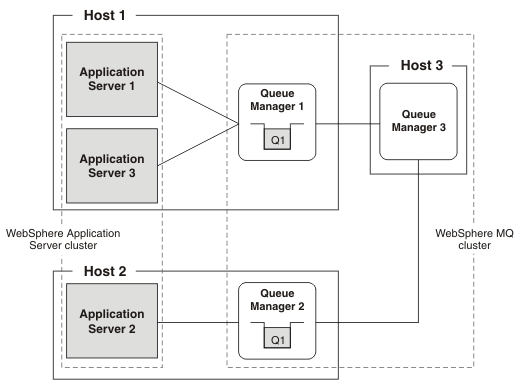Interoperation when WebSphere Application Server application servers are clustered and IBM MQ queue managers are clustered
IBM MQ queue managers are usually clustered in order to distribute the message workload and because, if one queue manager fails, the others can continue running.
In this topic "application server" refers to an application server running on WebSphere Application Server and "queue manager" refers to a queue manager running on IBM MQ.
There are two topology options:
- The queue managers run on different hosts from the application servers
- The queue managers run on the same hosts as the application servers
The queue managers run on different hosts from the application servers
In the subsequent figure:
- Application server 1, 2 and 3 are clustered in a WAS cluster.
- Application servers 1 and 3 are running on Host 1.
- Application server 2 is running on Host 2.
- Queue managers 1, 2 and 3 are part of the same IBM MQ cluster.
- Queue manager 1 is running on Host 3.
- Queue manager 2 is running on Host 4.
- Queue manager 3 is running on Host 5.
- Queue manager 3 is responsible for distributing messages between the cluster queues in a way that achieves workload balancing.
- A "client" connection is used when the application server and queue manager are running on different hosts. This is a TCP/IP network connection used to communicate with the queue
manager. A client connection is also known as "socket attach".
- Application servers 1 and 2 attach in client mode to queue manager 1.
- Application server 3 attaches in client mode to queue manager 2.
- Application servers 1 and 2 attach in client mode to queue manager 1.
Figure 1. WebSphere Application Server clustering: client mode attachment to queue managers

- If application server 1 fails:
- Application server 2 can take over its workload because they are both attached to queue manager 1.
- If application server 2 fails:
- Application server 1 can take over its workload because they are both attached to queue manager 1.
- If application server 3 fails:
- We must restart it as soon as possible for the following reasons:
- Other application servers in the cluster can take over its external
workload, but no other application server can take over its IBM MQ workload, because no
other application server is attached to queue manager 2. The workload generated by application server 3 ceases.
- Queue manager 3 continues to distribute work between queue manager 1 and queue manager 2, even though the workload arriving at queue manager 2 cannot be processed by application server 1 or 2.
If we choose not to restart, we can alleviate this situation by manually configuring Q1 on queue manager 2 so that the ability to put messages to it is inhibited. This results in all messages being sent to queue manager 1 where they are processed by the other application servers.
- Other application servers in the cluster can take over its external
workload, but no other application server can take over its IBM MQ workload, because no
other application server is attached to queue manager 2. The workload generated by application server 3 ceases.
- If queue manager 1 fails:
- You should restart it as soon as possible for the following reasons:
- Messages on queue manager 1 when it fails are not processed
until you restart queue manager 1.
- No new messages from IBM MQ applications are sent to queue manager 1, instead new messages are sent to queue manager 2 and consumed by application server 3.
- Because application servers 1 and 2 are not attached to queue
manager 2, they cannot take on any of its workload.
- Because application servers 1, 2 and 3 are in the same WebSphere Application Server cluster, their non-IBM MQ workload continues to be distributed between them all, even though application servers 1 and 2 cannot use IBM MQ because queue manager 1 has failed.
Although this networking topology can provide availability and scalability, the relationship between the workload on different queue managers and the application servers to which they are connected is complex. We can contact the IBM representative to obtain expert advice.
- Messages on queue manager 1 when it fails are not processed
until you restart queue manager 1.
The queue managers run on the same hosts as the application servers
In the subsequent figure:
- Application severs 1, 2 and 3 are part of the same WebSphere Application Server cluster.
- Application servers 1 and 3 are running on Host 1.
- Application server 2 is running on Host 2.
- Queue managers 1, 2 and 3 are part of the same IBM MQ cluster.
- Queue manager 1 is running on Host 1.
- Queue manager 2 is running on Host 2.
- Queue manager 3 is running on Host 3.
- Queue manager 3 is responsible for distributing messages between the cluster queues in a way that achieves workload balancing.
- The transport type for the connection is specified as "bindings".
A "bindings" connection is used when the application server and the queue manager are running on the same host. This is a cross-memory connection used to communicate with a queue
manager. A bindings connection is also known as "call attach".
- Application servers 1 and 3 attach to queue manager 1 in bindings
mode.
- Application server 2 attaches to queue manager 2 in bindings mode.
- Application servers 1 and 3 attach to queue manager 1 in bindings
mode.
Figure 2. WebSphere Application Server clustering: bindings mode attachment to queue managers

- If application server 1 fails:
- Application server 3 can take over its workload because they are both attached to queue manager 1.
- If application server 3 fails:
- Application server 1 can take over its workload because they are both attached to queue manager 1.
- If application server 2 fails:
- We must restart it as soon as possible for the following reasons:
- Because no other application server is attached to queue manager 2 no other application server can take over its IBM MQ workload. The workload generated by application server 2 ceases. Other application servers in the cluster can, however, take over its external workload
- Queue manager 3 continues to distribute work between queue manager 1 and queue manager 2, even though the workload arriving at queue
manager 2 cannot be taken on by application server 2.
If we choose not to restart, we can alleviate this situation by manually configuring Q1 on queue manager 2 so that the ability to put messages to it is inhibited. This results in all messages being sent to queue manager 1 where they are processed by the other application servers.
- Because no other application server is attached to queue manager 2 no other application server can take over its IBM MQ workload. The workload generated by application server 2 ceases. Other application servers in the cluster can, however, take over its external workload
- If queue manager 1 fails:
- We must restart it as soon as possible for the following reasons:
- Messages on queue manager 1 when it fails are not processed
until you restart queue manager 1.
- Because application servers 1 and 3 are not attached to queue
manager 2, they cannot take on any of its workload.
- No new messages from IBM MQ applications are sent to queue manager 1, instead new messages are sent to queue manager 2 and consumed by application server 2.
- Because application servers 1, 2 and 3 are in the same WebSphere Application Server cluster, their non-IBM MQ workload continues to be distributed between them all, even though application servers 1 and 3 cannot use IBM MQ because queue manager 1 has failed.
- Messages on queue manager 1 when it fails are not processed
until you restart queue manager 1.
Although this networking topology can provide availability and scalability, the relationship between the workload on different queue managers and the application servers with which they are connected is complex. We can contact the IBM representative to obtain expert advice.